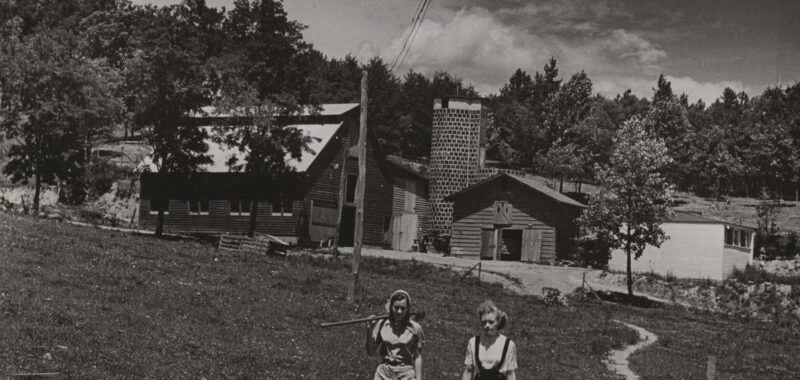Although the story of Black Mountain College (BMC) has been told more than once since its founding in 1933, the ending is always the same. In its prime, the radical, rural liberal arts college situated in the Appalachian Mountains of Western North Carolina was a testing ground for all manner of creative experiments, such as John Cage’s first “happening” and Buckminster Fuller’s first dome. But BMC eventually caved, literally and figuratively, with buildings falling into disrepair and people reaching their breaking points as economic hardship increased, tempers shortened, and communal enthusiasm waned. The school officially closed in 1957, after 24 years of striving for an art education centered on self-sufficiency.
What is less widely known, until now, is the story of the BMC farm and its role in the college’s success — and ultimately, its downfall. In The Farm at Black Mountain College, author David Silver takes up this task, privileging the stories and amplifying the voices of those whose hands built the school and whose dreams shaped its programs, all of which involved the farm in one way or another.
The inclusion of farming in BMC’s programming stemmed from its progressive educational framework, which, as Silver explains, arose from student interest and grew from their initiative. Beyond hands-on agricultural lessons, the farm’s reach extended to include construction, carpentry, electrical systems, plumbing, economics, and more, giving shape to the curriculum and practical purpose to a day’s work. In turn, the farm fed a revolving door of students, faculty, staff, and visitors, which included now-legendary artists such as Anni and Josef Albers, Ruth Asawa, Merce Cunningham, and Willem de Kooning. Eventually, however, the exhausting physical demands of farm labor outweighed its experiential rewards, even if that meant going hungry.

Informed by a well of original research, Silver’s account begins and ends with a car crash in the summer of 1955, intentionally caused by one of the few remaining BMC students who had consumed too much Ballantyne beer and too little food for too long — a fitting scene for the book’s narrative arc. The once burgeoning, abundant farm at BMC’s Lake Eden campus — which included fruit trees and vegetable gardens, surrounded by buildings that housed livestock such as chickens, hogs, and cows — lay neglected that summer after consistently declining during prior seasons. A pair of photos in The Farm display these dire conditions: A small group of hangers-on looks emaciated and bedraggled at the last BMC community gathering, a far cry from the energetic and enthusiastic students from the college’s early years pictured elsewhere in the book.
Silver attributes much of the exasperation and deterioration to the lack of food and other necessary resources on campus. He details grim accounts of “poker,” a student game of stealing food from wherever they could find it (including the local A&P), and tales of hot dog soup, a barely there meal assembled by boiling hot dogs, using the water as broth, and adding whatever remaining herbs could be foraged from the garden.
The BMC farm was arguably most productive during the six-year tenure of instructor Mary “Molly” Gregory, who arrived as Josef Albers’s teaching apprentice in 1941 when women were running the farm and school after the men had been drafted into World War II. According to Silver, not much attention has been given to what happened at BMC during the years of the war, but he provides evidence of “a flurry of activity performed by the women who remained on campus.” Under Gregory’s leadership, he writes, “the college spent much of the war growing all of its food, and against all wartime odds, building an ambitious series of farm structures. Along the way, Molly assembled a group of female students who would bring the college closer to self-sufficiency than it ever had been or ever would be.”

Within a year of Gregory taking the lead, the BMC farm had a surplus. Before she left the college in 1947, Gregory raised the roof of the farmhouse — with Ruth Asawa’s help — to accommodate her replacements, which she identified through her broad network: two pairs of husband-and-wife farmers.
The remainder of The Farm traces the floundering leadership and mismanagement of BMC agricultural efforts and related work programs, coming full circle to the driver’s seat of the crashed car. Black Mountain College had come to an end.
For readers who are wary of another BMC book, or curious about how the farm has informed contemporary artists’ work with homesteading, community gardens, and seed saving, take note that Silver’s account is not a “how-to” book about communal living, art making, farming, or DIY education. Instead, he poignantly portrays the ever-elusive nature and romantic appeal of self-sufficiency complicated by the demands of modern life, creative muses, and clashing egos, all within the context of two of our most pressing needs as humans: food and community.




The Farm at Black Mountain College (2024) is published by Atelier Éditions in conjunction with the exhibition The Farm at Black Mountain College, curated by David Silver and Bruce Johansen and on view at Black Mountain College Museum and Art Center through January 11, 2025. The book is available online and through independent booksellers.

